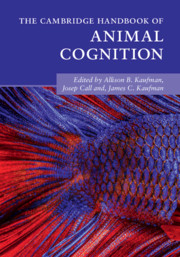Book contents
- The Cambridge Handbook of Animal Cognition
- The Cambridge Handbook of Animal Cognition
- Copyright page
- Dedication
- Contents
- Figures, Tables, and Boxes
- Contributors
- Acknowledgments
- Introduction
- Part I Communication and Language
- Part II Memory and Recall
- Part III Social Cognition
- Part IV Social Learning and Teaching
- Part V Numerical and Quantitative Abilities
- Part VI Innovation and Problem-Solving
- 28 Innovation and Problem-Solving Overview
- 29 General Intelligence (g) in Mice
- 30 Bowerbird Innovation and Problem-Solving
- 31 Parrot Innovation
- 32 Innovation in Marine Mammals
- 33 Innovation in Capuchin Monkeys
- 34 Innovation and Problem-Solving in Orangutans
- 35 Do Apes and Monkeys Know What They (Don’t) Know?
- 36 Decision Making in Animals
- Index
- References
28 - Innovation and Problem-Solving Overview
from Part VI - Innovation and Problem-Solving
Published online by Cambridge University Press: 01 July 2021
- The Cambridge Handbook of Animal Cognition
- The Cambridge Handbook of Animal Cognition
- Copyright page
- Dedication
- Contents
- Figures, Tables, and Boxes
- Contributors
- Acknowledgments
- Introduction
- Part I Communication and Language
- Part II Memory and Recall
- Part III Social Cognition
- Part IV Social Learning and Teaching
- Part V Numerical and Quantitative Abilities
- Part VI Innovation and Problem-Solving
- 28 Innovation and Problem-Solving Overview
- 29 General Intelligence (g) in Mice
- 30 Bowerbird Innovation and Problem-Solving
- 31 Parrot Innovation
- 32 Innovation in Marine Mammals
- 33 Innovation in Capuchin Monkeys
- 34 Innovation and Problem-Solving in Orangutans
- 35 Do Apes and Monkeys Know What They (Don’t) Know?
- 36 Decision Making in Animals
- Index
- References
Summary
Innovation – the process that generates novel learned behaviours – is a defining feature of intelligence, and has long attracted the interest of scientists for its implications in brain evolution, emergence of culture, and adaptation to environmental changes. Although most animals have the capacity to innovate, only a few excel in their innovative capacities. A salient feature of these animals is a highly encephalized brain, which provides the cognitive basis for complex behaviors. Highly innovative animals also tend to be ecological generalists, long-lived and sociable, features that are thought to enhance the payoff of innovation. The evolutionary origin of innovative abilities is unclear, however, because innovating implies coping with problems the animal has not experienced before. A possibility is to consider innovation as an emergent property that results from the combination of cognitive and noncognitive traits that have coevolved as part of a life-history syndrome to cope with environmental changes. The coevolution of innovation and social learning capacities is particularly relevant because it has facilitated the accumulation of the knowledge needed for more complex behaviours. The ability to socially transmit knowledge may thus be behind the exceptional variety and sophistication of human innovations.
Keywords
Information
- Type
- Chapter
- Information
- The Cambridge Handbook of Animal Cognition , pp. 639 - 652Publisher: Cambridge University PressPrint publication year: 2021
